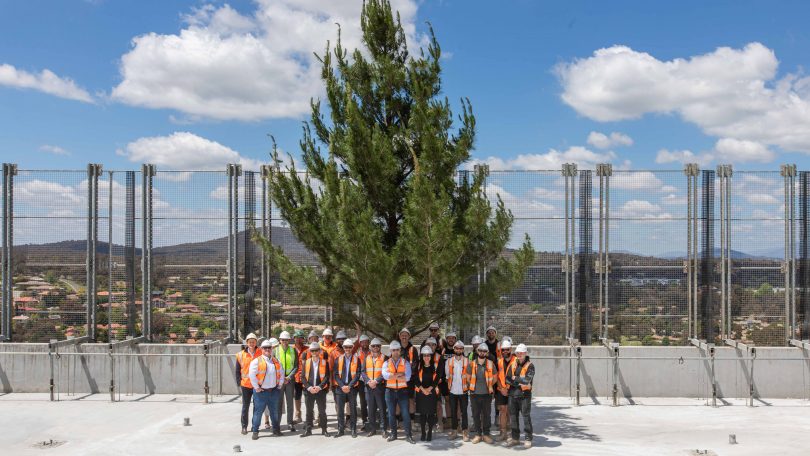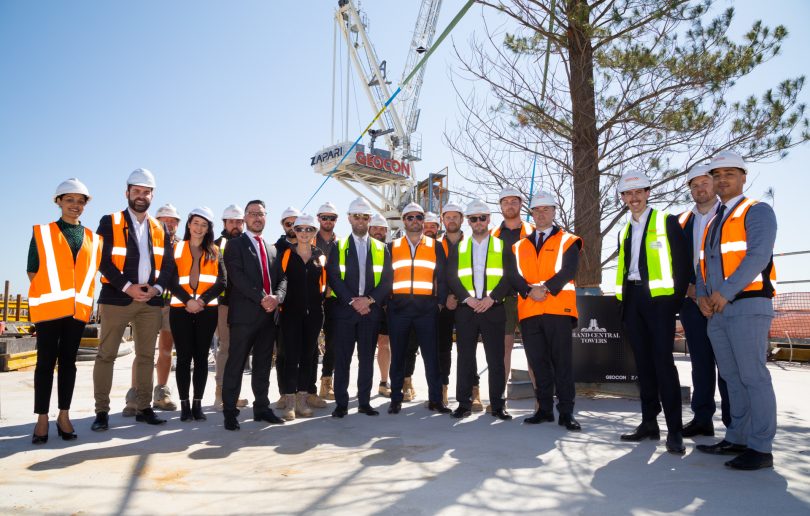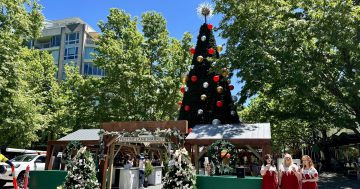
‘Topping out’ ceremony by Geocon at Nightfall. Photo: Geocon.
It’s 2630 BC, and Egypt’s sweeping hot sands are interrupted by the first of a new type of structure. The Step Pyramid of Djoser will become the resting place for the third-dynasty pharaoh, but as the scaffolding is cleared away, one task remains. The workers hoist a tree 60 metres to the top, a sign of everlasting life and homage to their colleagues who perished during the tomb’s construction.
Fast forward to today, and you’ll see a similar situation in Tuggeranong town centre. A half-built monolith of concrete is topped by a massive pine tree, but here the ‘topping out’ ceremony is just an excuse for a good old-fashioned party.
Geocon Construction Director Damian Rumball says ‘topping out’ has been a tradition at Geocon for over 10 years, and is now a feature of the Canberra construction industry.
“Whether or not there is a tree involved, nearly every single construction site in the ACT has a topping out ceremony in one way or another.”

The pine trees keep getting bigger. Photo: Michelle Kroll.
Records may track the first known instance to Egypt and the completion of the first pyramid, but it is better known as an ancient practice stemming from Scandinavia.
When the timber frame was completed, a tree was placed on the highest point to appease the tree-dwelling spirits whose habitat had just been destroyed. Somehow, chopping down one more tree did the trick.
“They used to do it to ward off evil spirits and bring good luck to the building’s occupants,” Damian says.
Viking invaders took the custom to Britain, and it spread throughout Europe, the US, Canada, New Zealand, and our own backyard.
“Someone has migrated here and brought their tradition with them and it has expanded from that,” Damian says.
JWLand celebrated the ‘topping out’ of two structures at their Founders Lane project in Braddon last April.
Construction Manager Nick Haralambous says the building industry in Australia may have adopted the tradition when international property company Civil & Civic (now LendLease) arrived.
“There must have been someone there who had some experience with it, and as a global company, they kept the tradition alive.”
Nowadays, Damian says it represents a mid-point in a construction project, “a good time to take stock and appreciate what we’ve done”.

The topping out ceremony at the Grand Central Towers in Woden. Photo: Michelle Kroll.
Geocon and JW Land use the tradition to start up the barbecue, crack open the beers, and “celebrate the progress we’ve made and thank everyone who has been involved”.
Typically it’s a pine tree, but Damian says he has heard of small olive trees and other species starring in the ceremonies.
“The trees seem to be getting larger and larger over the years. Internally, I think it has become a bit of a competition to get the biggest tree up there,” he says.
Geocon sources their trees from a property they own over the border in NSW. The trees are then craned to the top and, depending on their size, placed in a steel base specifically engineered to hold them.
Once the ceremony is over, the tree is either planted somewhere on the development or recycled.
“One in Tuggeranong has been chipped and those wood chips will be used in a landscaping portion of that project,” Damian says. “Otherwise, we’ll recycle them and use the material somewhere on the construction site.”
“It’s a bit of fun and a great way to promote the milestone.”

















